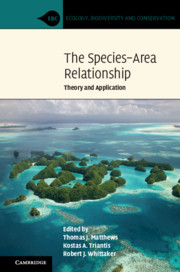Book contents
- The Species–Area Relationship
- Ecology, Biodiversity and Conservation
- The Species–Area Relationship
- Copyright page
- Contents
- Contributors
- Foreword
- Preface
- Part I Introduction and History
- Part II Diversity–Area Relationships: The Different Types and Underlying Factors
- 3 Explaining Variation in Island Species–Area Relationship (ISAR) Model Parameters between Different Archipelago Types: Expanding a Global Model of ISARs
- 4 Determinants of the Shape of Species–Area Curves
- 5 Functional and Phylogenetic Diversity–Area Relationships
- 6 Species–Area Relationships in Alien Species: Pattern and Process
- Part III Theoretical Advances in Species–Area Relationship Research
- Part IV The Species–Area Relationship in Applied Ecology
- Part V Future Directions in Species–Area Relationship Research
- Index
- References
5 - Functional and Phylogenetic Diversity–Area Relationships
from Part II - Diversity–Area Relationships: The Different Types and Underlying Factors
Published online by Cambridge University Press: 11 March 2021
- The Species–Area Relationship
- Ecology, Biodiversity and Conservation
- The Species–Area Relationship
- Copyright page
- Contents
- Contributors
- Foreword
- Preface
- Part I Introduction and History
- Part II Diversity–Area Relationships: The Different Types and Underlying Factors
- 3 Explaining Variation in Island Species–Area Relationship (ISAR) Model Parameters between Different Archipelago Types: Expanding a Global Model of ISARs
- 4 Determinants of the Shape of Species–Area Curves
- 5 Functional and Phylogenetic Diversity–Area Relationships
- 6 Species–Area Relationships in Alien Species: Pattern and Process
- Part III Theoretical Advances in Species–Area Relationship Research
- Part IV The Species–Area Relationship in Applied Ecology
- Part V Future Directions in Species–Area Relationship Research
- Index
- References
Summary
The species–area relationship (SAR) has been documented for a wide range of organisms, ecosystems and spatial scales. In contrast, little is known about the spatial scaling of functional and phylogenetic diversity, two other important facets of biodiversity. Describing and understanding how functional and phylogenetic diversity scale with area represents a promising research programme to unravel community assembly mechanisms across spatial scales, and to predict the loss of functional and phylogenetic diversity from habitat loss. In this review, our aim is to provide (1) practical recommendations to measure functional and phylogenetic diversity and to construct functional and phylogenetic diversity–area relationships, (2) a theoretical background on how to interpret the shape of phylogenetic diversity–area relationships and (3) an overview of the empirical phylogenetic diversity–area relationships published to date. We conclude by proposing a series of recommendations for future work.
Keywords
- Type
- Chapter
- Information
- The Species–Area RelationshipTheory and Application, pp. 107 - 132Publisher: Cambridge University PressPrint publication year: 2021
References
- 5
- Cited by

